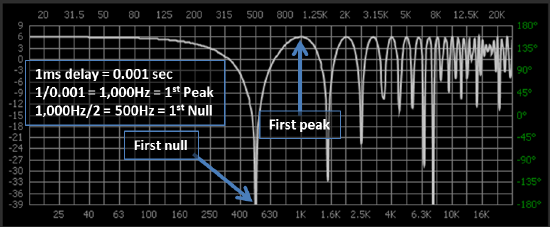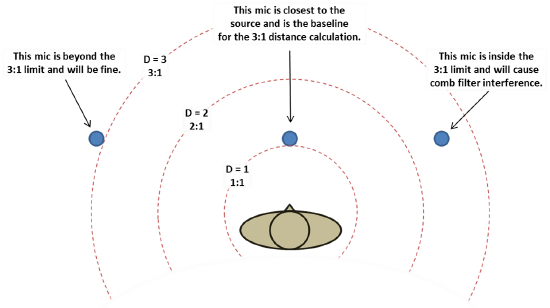Comb filters
This article describes how comb filters are caused and how to mitigate their effect with automixers.
Comb filter basics
Comb filters occur when two identical audio signals are summed together with a small delay between them. This is commonly experienced when two or more microphones pick up the same source and sum to the same output. The comb filter is the result of the phase offset in the summed audio signal - caused by the difference in path lengths to the microphones, resulting in multiple arrival times for the same signal at the summation point of the audio circuit.
If two microphones are exactly the same distance from the source, then the sound will arrive at each microphone at exactly the same instant and the signals will add together constructively across the audio spectrum. When two microphones are perfectly in time alignment, there will be no destructive interference because the phase relationship of the sources is aligned throughout the audible audio spectrum. The result of summing the two signals will be a 6dB increase in gain across the audio spectrum (a doubling of the gain).
If there is any difference in arrival time, then the signals will interfere with one another and result in comb filtering. The cause of the comb filter is the conflict in phase between of the two signals, which in turn is caused by the difference in the time of arrival of the sound at the microphones (due to a difference in distance from the acoustic source). At different wavelengths (frequencies) the phase response causes either constructive summation (causing a boost of up to 6dB) or destructive summation (causing nulls which can result in a complete cancelation of the signal). At the null maximums, the two signals are 180 degrees out of phase with one another.
(The reverse is also true. Comb filters can be heard when a mono signal is played through 2 or more speakers, the portamento sound you hear as you move between the speakers is the shift in frequencies of the comb filters as the relative distance (and thus delay times) changes between you and the speakers.)
The fundamental frequency of a comb filter is the inverse of the delay time. That is, the frequency of the first peak in a comb filter (constructive interference) is equal to 1 divided by the difference in arrival time between the microphones (the delay time), in seconds. This peak occurs as the first 360 degree phase shift of the delayed signal comes into alignment with the original signal.
The first null occurs at 1/2 of the first peak frequency (in Hz). Nulls occur when the delayed signal arrives 180 degrees out of phase from the original signal.
For a signal offset by 1 millisecond of delay (1 millisecond = 1/1000 second = 0.001 second), we can calculate the first peak using 1 ÷ 0.001 = 1,000Hz. The first null or cancelation happens at (1/delay time)/2 = (1/0.001)/2 = 1000/2 = 500Hz.
Peaks will recur at integer multiples of the first peak (eg - 1,000Hz x 2 = 2,000Hz; 1,000Hz x 3 = 3,000Hz, etc.), nulls will recur at values equal to the peak multiples minus the original null frequency (eg - 1,000Hz x 2 = 2,000 - 500 = 1,500Hz).
For a signal offset by 5 milliseconds of delay (5 milliseconds = 5/1000 second = 0.005 second), we can calculate the first peak using 1 ÷ 0.005 = 200Hz. The first null or cancelation happens at (1/delay time)/2 = (1/0.005)/2 = 200/2 = 100Hz.
For a signal offset by 10 milliseconds of delay (10 milliseconds = 10/1000 second = 0.010 second), we can calculate the first peak using 1 ÷ 0.01 = 100Hz. The first null or cancelation happens at (1/delay time)/2 = (1/0.01)/2 = 100/2 = 50Hz.
Distance and volume
Fortunately, as distance changes so does volume. Peaks and nulls become less pronounced as the difference in relative levels between the microphones becomes greater. Take a look at some examples in the illustration below. Rather than the absolute cancellation seen in the examples above, here we see shallower peaks and nulls as the relative volume of the sources change.
The greatest summation (almost +6dB) and deepest nulls (about -10dB) are seen between microphones A and B, whose levels are just 3dB apart. Since their gain levels are closest, these microphones present the most interference with one another.
While microphones A and C have the greatest physical separation from one another, they do not have greatest gain difference (relative to one another). Microphones B and C have the largest separation in gain, about 8dB, thereby creating the least interference with one another and thus we see the shallowest ripples in the response curve.
Minimizing comb filtering
Comb filtering can be minimized by placing microphones as close as possible to the people that are speaking into them. There is a popular microphone placement adage that is known as the "3 to 1 Rule". The 3 to 1 Rule says that if multiple microphones can hear the same source, then no other microphone should be less than 3 times the distance to the source for the microphone nearest the source. In other words, if a person is talking into a microphone that is one foot away from them, then no other microphone in the room should be closer than 3 feet away from that person in order to minimize comb filtering.
There are many situations where it is not practical to follow the 3 to 1 Rule. A conference room with ceiling microphones is a good example of such a situation. Even if you are sitting relatively close to a ceiling microphone, you might be 5 feet away from it. This means that the next closest microphone has to be at least 15 feet away from you in order to minimize comb filtering. Placing ceiling microphones so far apart will lead to major gaps in coverage.
A way to minimize comb filtering in these types of situations is to use a gating automixer or a gain sharing automixer on the microphones. Automixers will help by attenuating the secondary microphones, thereby increasing the gain difference between the microphones and reducing the depth of the comb filters. Biamp's gating automixer senses similar material in multiple microphones (e.g., one person heard by 3 microphones) and only un-mutes the dominant microphone. If different voices are heard at different microphones then more gates will open. Even in applications where the 3 to 1 Rule is being followed, automixers can help to further minimize comb filtering and reduce background noise by eliminating unused microphones.



